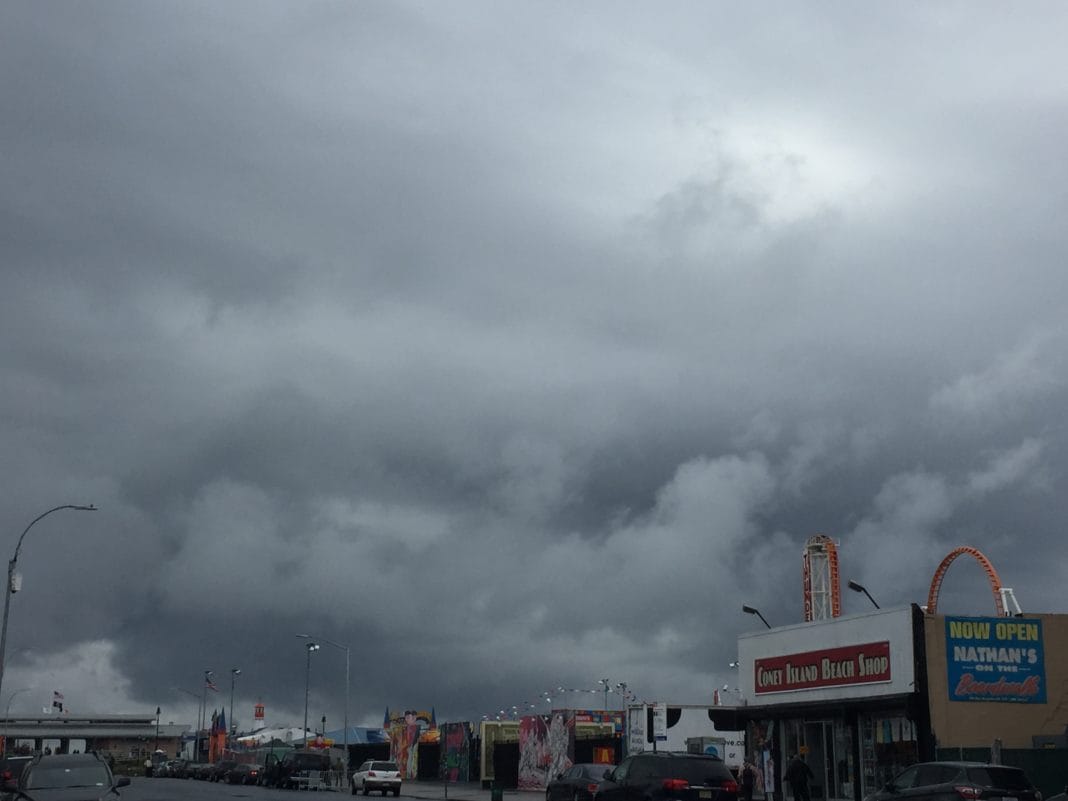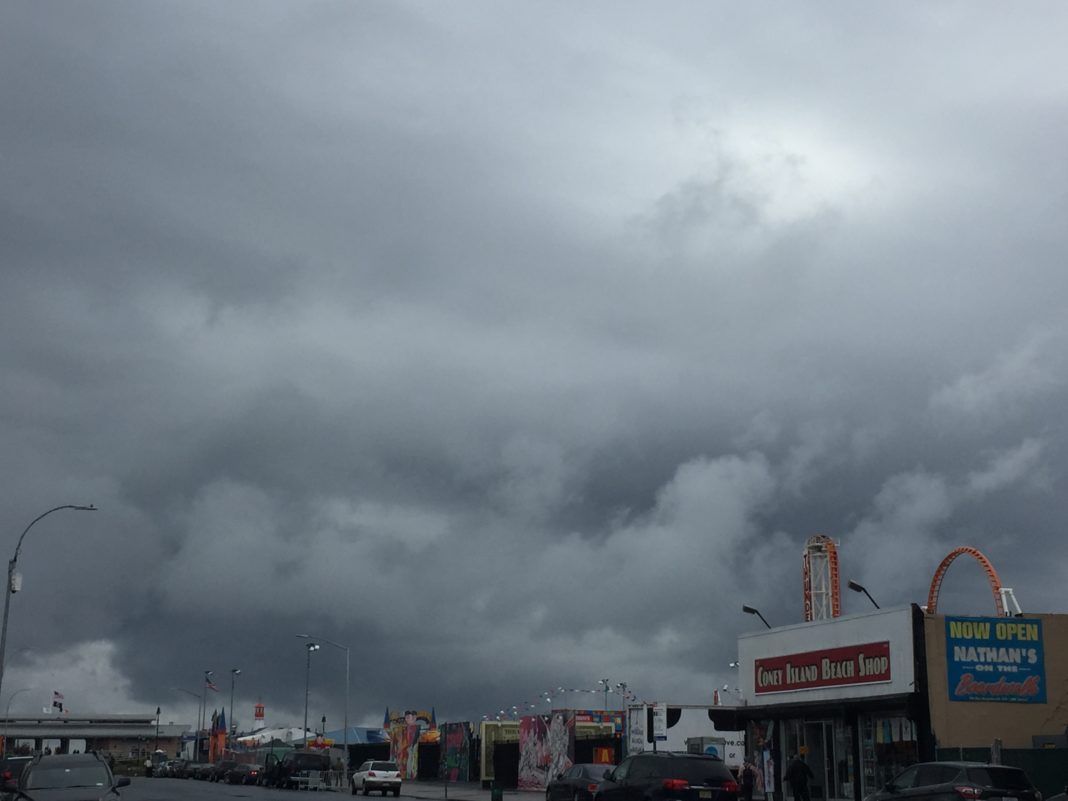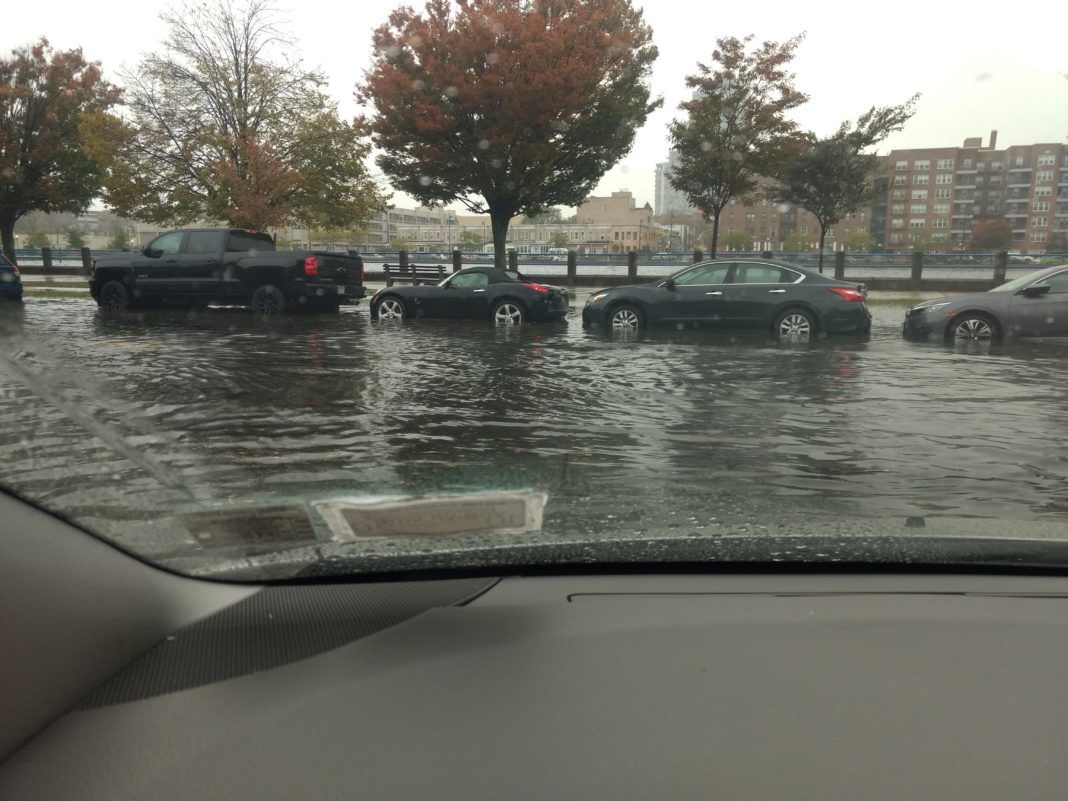Is Brooklyn Prepared For A Big Storm? City Says Yes, Local Pols Say No.


It’s September which means it’s officially storm season. Forget hurricanes, it seems that every time it pours, Brooklyn gets flooded even though over $20 billion was allocated for the City’s resiliency plan. Puddles form on streets, water goes up above ankles, and the subway stations are a whole other story. Which leads us to wonder, if a storm were to make its way in Brooklyn tomorrow, are we ready?
The Mayor’s Office of Resiliency believes the City is more resilient than ever.
“We’re bolstering New York City’s defenses against climate threats with a bold and unprecedented $20 billion resiliency plan,” Jainey Bavishi, Director of the Mayor’s Office of Resiliency told Bklyner. “There is no quick fix for the risks we face, but the City’s efforts have already made New Yorkers safer and will continue to ensure that our neighborhoods, economy, and public services will be ready to withstand and emerge stronger from the impacts of climate change.”
Many elected officials don’t think so.
Just a few days ago, Comptroller Scott Stringer (who’s running to be the next Mayor) penned a letter to Mayor Bill de Blasio asking him to detail specific steps “taken to reform emergency preparation plans and spotlighting breakdowns in the City’s response to Superstorm Sandy that left NYCHA residents more vulnerable, stalled recovery efforts, and jeopardized vital services.”
In the letter, he states, “As climate change escalates and sea levels continue to rise, New York City must be prepared to contend with the ever greater risk posed by hurricanes and floodwaters… While the City has an obligation to invest today in the resilient infrastructure and necessary safeguards that can shield homes and businesses from the impacts of the next storm, we must also be prepared to quickly mobilize to help protect New Yorkers the moment the next disaster strikes.”
274 4th Ave. Outside the Colony. pic.twitter.com/jGVDyGHeHX
— SJAvery (@brooklynsja) July 23, 2019
Stringer asked for the following information from the Mayor:
- steps taken to ensure that NYCHA is able to contact and assist NYCHA residents with disabilities who may need assistance during a disaster;
- efforts undertaken to implement the Comprehensive Emergency Management Plan at every NYCHA development across the City;
- steps taken to systematically conduct drills, exercises, and other training events at all NYCHA developments including instituting a multi-year training and exercise schedule;
- review of the Build It Back program and best practice recommendations for future similar programs;
- plans to better coordinate emergency purchases of crucial supplies and services which can protect New Yorkers;
- and policies relating to the use of interim flood protection measures, such as pre-deployed barriers and ‘just-in-time’ flood measures.
“It’s not a question of whether New York will be hit by another superstorm like Sandy, but when. Yet nearly seven years after Sandy struck, we still haven’t fully recovered and too many New Yorkers remain vulnerable to the next storm. Over the past six years my office has cataloged the many ways the City failed New Yorkers in the hours, months, and years after Sandy,” Stringer said. “Our City is responsible for mobilizing to protect New Yorkers the minute the next storm strikes and we can’t let NYCHA residents, shorefront communities, or vulnerable New Yorkers suffer because we didn’t learn our lessons from Sandy.
“It’s past time for the City to reassure New Yorkers that we are better prepared than we were six years ago,” he continued.
Bay Ridge Council Member Justin Brannan, who chairs the Committee on Resiliency and Waterfronts, said efforts should also focus on Brooklyn, and thinks the City is “woefully unprepared.”
“Climate crisis isn’t on the horizon, it’s already on our shores and streets, and we see it with every storm. We are woefully unprepared – from our infrastructure to our energy grids, to our emergency protocol. We’ve got streets flooding with raw sewage every time it rains, and homeowners still recovering from Sandy,” he said.
“We need a comprehensive, urgent plan to upgrade our energy grid and infrastructure to prepare for the next Sandy, especially in Brooklyn. Don’t get me wrong, I understand why lower Manhattan is important,” he continued, “but every time we focus our efforts there we are giving short shrift to working and middle-class families along all of our city’s shorelines – residents in the so-called outer-boroughs who are literally on the front lines of the war on climate change whether they like it or not.”

Congress Member Max Rose agreed and said, “It’s not a matter of if, but when the next superstorm comes so we must be prepared. And while the city seems to recognize this fact when it comes to spending billions to protect Wall Street from future hurricanes, it seems unfair that South Brooklyn and Coney Island can’t make it through a simple rainstorm without major flooding.”
Last year, we reported on the various reasons why Brooklyn still wasn’t resilient to storms. Though they were badly destroyed during Hurricane Sandy, local hospitals received much funding to rebuild and to become more resilient, and are quite possibly the only ones that are ready should another storm blow in.
In 2014, the NYC Health and Hospitals/ Coney Island received $923 million in FEMA funds that “include reimbursement for repairs to Hospital facilities for damage incurred during Hurricane Sandy, and funds for mitigation projects that will protect the hospital from the impact of future extreme weather.” It was in addition to the $143 million the hospital had received “from FEMA for emergency stabilization measures, partial repairs, and temporary flood barriers.” In 2017, we took a look at how those improvements were looking.
“As I said after the terrible flash flooding that Borough Park, Gowanus, Williamsburg, and other areas experienced in late July; we have to expect more intense storms with increased climate change,” Borough President Eric Adams told Bklyner. “Hurricane season reminds us that our city can and must be better prepared, from bolstering our stormwater management infrastructure and improving our drainage capacity with rain gardens and blue/green roofs to partnering with residents and businesses to assist in proper catch basin maintenance.”
Despite the concerns of local politicians, the Mayor’s office believes the City is prepared and more resilient than ever before, though more work remains to be done to guard against climate threats to NYC. At Bklyner’s request, the Mayor’s Office of Resiliency provided us with the following information:
- More than $20 billion in City and federal dollars are being invested to take actions and build a resilient city to prepare for future storms and help protect the City from climate change.
- The City’s multi-layered adaptation strategy recognizes the necessity of addressing climate threats—including storm surge, sea-level rise, extreme heat, and extreme precipitation— on multiple fronts.
- Coastal resiliency was increased and includes a T-groin and sand nourishment project in Sea Gate and 4.2 million cubic yards of new sand that have been placed on city beaches in the Rockaways and Coney Island, among others.
- Progress is being made on the Red Hook Integrated Flood Protection System, though it isn’t completed yet.
- The City has installed Interim Flood Protection Measures (which provide temporary protection while permanent resiliency measures are designed and constructed) at 52 sites across the City, including in Red Hook.
- Construction has begun this year on 5,000 curbside rain gardens which when completed will bring more than 9,000 to the five boroughs. By soaking up stormwater and keeping it out of the City’s sewer system, the Rain Gardens help to reduce flooding and sewer overflows into local waterways.
- Zoning and building codes have been upgraded to increase resiliency.
- The City has invested tens of millions in multiple programs to provide free risk assessments and grants for resiliency improvements for small businesses in Sandy-impacted areas.
Additionally, the Office says that Con Edison has invested over $1 billion on improvements such as reconfiguring underground electric networks, securing tunnels carrying steam and gas mains and high-voltage electric feeders to protect them from flooding, and installing new, storm-proof doors. But, then we still get black-outs that occurred over the summer. According to the Mayor’s Office, three major projects (U.S. Army Corps of Engineers’ Rockaway Reformulation project, the East Side Coastal Resiliency project, and the Staten Island Coastal Storm Risk Management Project) will break ground next year. None of them are in Brooklyn.
Some of the improvements to resiliency do take into account the floods the occur when it simply pours, and rain gardens that have been rolling out across Brooklyn should help with some of this. But still, it’s not enough. In July, for example, Gowanus flooded because “the Park Slope neighborhood was receiving nearly three inches of rain an hour, which exceeds the capacity of the drainage system,” turning streets into rivers, a spokesperson for the Department of Environmental Protection told us at the time.
“We are better informed, but we are not better prepared for the next super storm or hurricane, especially in the outer boroughs. As far as stronger protections go we have a lot more to do. The City of New York does not have a regional resiliency plan in place or funding to appropriately address our infrastructure inadequacies,” Council Member Mark Treyger told Bklyner. “Additionally, soon FEMA will be announcing the new flood maps which will mandate thousands of New Yorkers to purchase flood insurance, disproportionately affecting fixed-income residents in my district.”
“Seven years after Superstorm Sandy and Southern Brooklyn is still recovering and rebuilding,” he continued. “I urge the Mayor’s Office of Resiliency to take this time of year as a reminder that we must be doing more, lobbying Congress for funding while boosting locally-led planning, to ensure our city begins implementing safety and resiliency measures before the next storm hits.”
This is part one of our new series – stay with us at we break down storm preparedness for you in the upcoming weeks.




